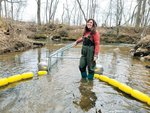


Pollutants in the Haw River have made headlines across the state in the past year, but nowhere is the impact of those pollutants greater than in Chatham County.
This week, we bring the second of a two-part interview with two of the leading voices fighting for a cleaner Haw River — Emily Sutton of the Haw River Assembly and Katie Bryant of Clean Haw River. The discussion below is a follow-up to a recent edition of The Chatcast, the podcast of the News + Record, which can be heard here.
Sutton joined the staff of Haw River Assembly in 2016, managing citizen science projects to watchdog against sediment pollution and monitor the tributaries and main stem of the Haw River. As Riverkeeper, she is now leading the fight against pollution in the Haw River on many fronts, including emerging contaminants, Jordan Lake nutrients, and sediment pollution.
Bryant moved to Pittsboro in the summer of 2011. She is a microbiologist and clean water activist dedicated to combating America’s water crisis.
Her background includes biomedical research and development, and pharmaceutical and personal care quality assurance. She and her family live just outside Pittsboro.
SUTTON: The Clean Water Act mandates that any discharge into waters must be disclosed in a discharge permit. That federal law is clear, even though our state regulatory agencies have failed to require disclosure on permits. However, the process for regulating how much of something can be discharged is painfully slow. Chemical manufacturers are not required to disclose what their compounds contain, what it is used in, where it is discharged, or what the health risks are of that chemical compound. They are given an “innocent until proven guilty” status.
Once a contaminant is discovered and identified through sampling and analysis, the process for regulating it takes years of health studies and scientific research before it will be considered on the EPA’s “Contaminant Candidate List,” which may or may not lead to regulatory limits in the subsequent years. Meanwhile, communities are being exposed to these toxins every day.
For PFAS, two compounds within that class of 10,000+ have regulatory limits. PFOS and PFOA levels can not exceed 70ug/L, which has been widely criticized for being far too high. Other states are beginning to regulate PFAS with a class approach. This prevents the regulatory “whack-a-mole” for chemical companies; one compound gets regulated and another with a slightly changed chemical composition is put in its place.
For 1,4-Dioxane, we have a numeric limit of 0.35ug/L in water supply watersheds. This regulatory limit needs to be strongly enforced by our state agencies in order to have meaningful protection for communities downstream.
BRYANT: Regarding PFAS, as Emily said, we currently have an EPA health advisory limit of 70 ppt for PFOS and PFOA (only two of the nearly 8000 versions of PFAS). However, that limit is useless since PFOS and PFOA have been phased out of manufacturing. We now have shorter chain PFAS coming downstream to Pittsboro that are showing to pose an even bigger risk to human health.
The EPA has had enough data to make changes in these health advisory limits — and experts agree the limits should reflect the class of compounds, not one or two. For instance, some states are trying to pass a standard of 10 ppt to include all PFAS collectively which is a more reasonable demand considering these compounds are still being used daily in manufacturing. Experts, however, are also arguing 1 ppt collectively should be the max when considering the bioaccumulation — but this is nearly impossible to be adopted into regulation.
We need more protection in Pittsboro. Our water has been used as positive controls in studies here in the state — this is not OK. I am confident as research continues to reveal the impact these compounds are having on towns like Pittsboro; the water users will be able to move forward with legal action. I’ve already started putting my energy into this and hoping to make progress this year.
BRYANT: Clean Haw River is now focusing on creating more conversations between Pittsboro and upstream polluting municipalities. We spoke in December at the Greensboro board of commissioners’ meeting in hopes of creating a relationship and regular communication. Based on the most recent 2021 dumps of 1,4-Dioxane into the Haw River and the lack of enforcement of the Special Order of Consent, we thought it would be beneficial for the BOC members to see the faces of their neighbors they are sending toxic water to. We plan to keep this momentum and will be speaking soon to Reidsville and Burlington as well.
SUTTON: We are continuing our investigation with the City of Burlington to identify the industrial facilities responsible within that system for the PFAS discharges in order to eliminate that contamination. We are also working to ensure Greensboro meets the monitoring requirements agreed to in our challenge of the Special Order by Consent.
I am working with Riverkeepers across the state to identify potential sources of PFAS: landfills, airports, military bases, wastewater treatment plants, and industrial dischargers. We are pushing N.C.’s Department of Environmental Quality to uphold the federal laws laid out in the Clean Water Act and require disclosure, but move beyond that bare minimum requirement to use the analysis done nationwide to move towards a regulatory limit on PFAS as a class.
SUTTON: In the next 10 years, we are going to see exponential growth in this county. This will lead to increases in water use, water discharges, and pollution from development. The proposed water allocation transfer from Sanford poses the same risks of contamination that we see now — the levels of PFAS and 1,4-dioxane in Sanford have been even higher than our levels in the Haw. Increasing the quantity of our intake from the Haw could leave the river below adequate flow levels in times of droughts. The expansion to use Jordan Lake as a reservoir is a much safer alternative.
The risks of unchecked development are a major concern for us. Clearing 6,000 acres of forest to build out Chatham Park will result in a significant loss of trees and buffers along streams and the Haw River. Those trees filter out pollutants, slow velocity of runoff and hold in the soil to prevent sedimentation and erosion. We have been monitoring development associated with Chatham Park and have already seen significant sedimentation issues in every major rain event. We have a citizen science program to help us identify sedimentation issues and report them to county officials. I urge community members to take part and help us to keep an eye on development and prevent sedimentation from polluting our streams.
BRYANT: The water will be a concern for some time. This isn’t going away anytime soon. Because these contaminants persist and bioaccumulate, cleaning up and tracking down the contamination will last long after laws and regulations are passed. In addition to identifying our industry polluters we need to be aware of the following:
1. North Carolina has unlined landfills leaching into waterways (potentially into groundwater) that desperately needs to be addressed.
2. Sludge (biosolids from wastewater treatment) applied to land is running off into the river during rainy seasons and needs to be screened before being land applied.
3. The urban water cycle holds these contaminants within the cycle and are found in the soil, air, and locally grown foods. These too will need to be screened to ensure our safety by the FDA.
4. Improved infrastructure and more advanced treatment technology will be required as new chemicals are used in manufacturing processes- this will be imperative to get ahead of the chemical industry.